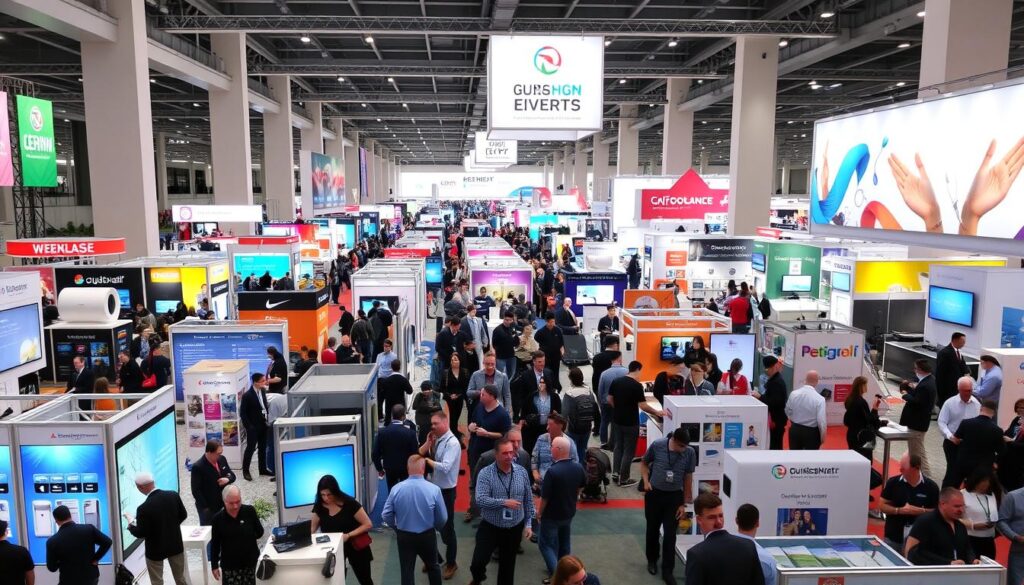תערוכות מסחר מציעות לעסקים דרך עוצמתית להציג מוצרים ולהתחבר ללקוחות. עם הרבה מציגים שמתחרים על תשומת לב, יצירת תערוכה יוצאת דופן היא קריטית. מדריך זה מספק טיפים חיוניים לתכנון נוכחות מוצלחת בתערוכה מסחרית.
נכסה יצירת אסטרטגיה משכנעת ועיצוב תערוכה מופעלת. תלמד גם כיצד למקסם את ההשתתפות של המבקרים ולמדוד את הצלחתך בתערוכה מסחרית.
מסקנות מרכזיות
- פיתוח אסטרטגית תערוכה מסחרית ברורה המותאמת למטרות העסק שלך ולקהל היעד שלך
- עיצוב תערוכה מופעלת המעבירה בצורה אפקטיבית את המותג שלך ומציעה חוויה זכורה
- העסקת מבקרים דרך תצוגות אינטראקטיביות, צוות מיומן ותוכן שימושי
- ניצול טקטיקות שיווק, דיגיטליות ומסורתיות כאחד, לקידום הנוכחות שלך בתערוכה מסחרית
- מדידת הצלחת ההשתתפות שלך בתערוכה מסחרית על ידי מעקב אחר לידים, מכירות והחזר על השקעה
יצירת אסטרטגיית תערוכות מסחר משכנעת
אסטרטגיה חזקה לתערוכת מסחר היא מפתח לתערוכה מוצלחת. התחילו על ידי קביעת מטרות ברורות להשתתפותכם. המטרות הללו ינחו את תכנון הפעולות שלכם ויתאימו למטרות העסקיות שלכם.
הגדרת המטרות והמטרות העסקיות שלכם
שקלו את הגורמים הללו בעת קביעת מטרות לתערוכת מסחר:
- ייצור לידים: כמה לידים חדשים אתם מקווים לרכוש?
- מודעות למותג: איזה הודעה אתם רוצים להעביר על מותגכם?
- שקיעת מוצרים: אילו הצעות חדשות אתם מתכננים להציג?
- מכירות: אילו מטרות בהכנסות או מכירות אתם מקווים להשיג?
מטרות ברורות יעזרו לכם ליצור אסטרטגיה ממוקדת ומשפיעה. התערוכה שלכם תהיה יותר אפקטיבית עם מטרות מוגדרות היטב.
הבנת הקהל היעד שלכם
חקרו את הקהל היעד שלכם בצורה מעמיקה להופעה מוצלחת בתערוכת מסחר. הבינו את נקודות הכאב שלהם, העדפותיהם והרגלי הקניה שלהם. הידע הזה יעזור לתערוכתכם להתקשר אליהם.
פתחו דמויות קונות כדי להשיג תובנות עמוקות יותר על המשתתפים האידיאליים שלכם. השתמשו בתובנות אלו כדי להתאים את ההודעות והפעילויות שלכם.
יישרו את האסטרטגיה שלכם עם המטרות והקהל היעד שלכם. הגישה הזו תיצור תערוכה משכה שתבלט. ההתעסקות שלכם עם המשתתפים תהיה יותר משמעותית ויעילה.
עיצוב תערוכת מסחר מופעלת
כניסת התערוכה שלכם היא לב התערוכה שלכם. עליה למשוך ולעסוק במבקרים בצורה יעילה. זהות המותג שלכם צריכה להיות במרכז.
לוגואים, צבעים והודעות יוצרים נוכחות קוהסיבית. תכנון טוב מעודד זרימת מבקרים ואינטראקציה. תצוגות אינטראקטיביות, הדגמות מוצרים ואזורי ישיבה נעימים משפרים את החוויה.
שילוב אלמנטים של מיתוג
התאימות היא חיונית בעיצוב התערוכה שלכם בתערוכת מסחר. יישרו את הוויזואלים של התערוכה שלכם עם זהות המותג שלכם. זה כולל גרפיקות, צבעים וטיפוגרפיה.
מראה מוכר יוצר אמון עם הקהל שלך. זה עושה את הסטנד שלך יותר זכור ומעניין.
יצירת פריסה מעניינת
- פיתוח תוכנית פריסה אסטרטגית שמובילה את המבקרים דרך התערוכה שלך, מעודדת אותם לחקור ולפעול עם המוצרים או השירותים שלך.
- שילוב אלמנטים אינטראקטיביים, כמו תצוגות מגע או הדגמות מוצרים, כדי ללכוד את תשומת ליבם של המשתתפים ולקדם שיחות משמעותיות.
- ספק אזורי ישיבה נוחים בהם המבקרים יכולים לנוח ולהתעסק עם הצוות שלך, תורמים ליצירת אווירה שמקבלת ומזמינה.
| רכיב | תועלת |
|---|---|
| מיתוג | משפר זיהוי מותג ויוצר זהות חזותית רציפה |
| תצוגות אינטראקטיביות | מגבירות את ההתמודדות של המבקרים ומקלות יצירת לידים |
| כיסאות נוחים | מעודדות את המשתתפים לבלות יותר זמן בסטנד שלך ולבנות קשרים |
כנס מסחר עם עמדת תצוגה מעוצבת היטב יכולה ליצור רושם חזק. זה מציג את המותג שלך בצורה יעילה. זה גם מעודד אינטראקציות משמעותיות עם לקוחות פוטנציאליים.
כנסים: מקסימיזציה של מעורבות המבקרים
עמדת התצוגה שלך בכנס מסחר דורשת יותר מעיצוב נהדר. זה דורש חוויות מעורבות שמשקיפות על המשתתפים. אלמנטים אינטראקטיביים כמו הדגמות מוצרים, משחקים או פעילויות מעשיות יכולים ליצור קשרים עמוקים עם לקוחות פוטנציאליים.
אימצו את הצוות שלכם בעמדת התצוגה כדי להיות מיומנים ונגישים. היכולות שלהם להתחיל בשיחות משמעותיות יכולות להשאיר רושם שייך. גישה זו יכולה להוביל ללידים פוטנציאליים וליצור אינטראקציות שנשארות בזיכרון.
כדי לשפר מעורבות של מבקרים בכנס מסחר, הוסיפו חוויות אינטראקטיביות ל-פעילויות בעמדה שלכם. שקלו להשתמש בתצוגות אינטראקטיביות, הדגמות במציאות וירטואלית או חוויות בסגנון משחק. אלה האלמנטים מעודדים את המבקרים להתערב במוצרים שלכם בדרכים כיפיות.
| חוויות עמדה אינטראקטיביות | יתרונות |
|---|---|
| הדגמות מוצרים | מאפשר למבקרים לראות את המוצרים שלך בפעולה ולהבין את התכונות והיכולות שלהם. |
| משחקים אינטראקטיביים או אתגרים | מעורר עניין אצל המבקרים בדרך כיפית וזכורה, מעודד אותם לבלות יותר זמן בעמדת התצוגה שלך. |
| חוויות מציאות וירטואלית (VR) | מספק דרך ייחודית ואימרסיבית למבקרים להתקשר עם המוצרים או השירותים שלך. |
חוויות מעוררות ואינטראקטיביות יכולות למקסם את העיסוק של המבקרים בקיוסק התערוכה שלך. הגישה הזו מביאה לשיחות מוצלחות וללידים מוסמכים. בסופו של דבר, זה מתרום לאירוע מוצלח בכלליו.

קידום הנוכחות שלך בתערוכת המסחר
שיווק לפני התערוכה הוא מרכזי להצלחה בתערוכות מסחר. זה עוזר למשוך משתתפים וליצור תעלומה סביב המותג שלך. שילוב של רשתות חברתיות וטקטיקות מסורתיות יכול לבנות ציפייה ולהוביל תנועה לתערוכתך.
משיכה מרשתות חברתיות
פלטפורמות רשתות חברתיות מציעות דרכים עוצמתיות לקידום הנוכחות שלך בתערוכת המסחר. השתמש ב-LinkedIn, Twitter ו-Instagram כדי לשתף פרטים מראש ולהדגיש הצעות מיוחדות. עורך קשר עם המשתתפים בזמן אמת והשתתף בשיחות הקשורות לתעשייה.
השתמשו בתגיות רלוונטיות כדי להגביר את הנראות שלכם. עודדו את צוותכם להשתתף בפעילויות מקוונות על האירוע.
- צרו לוח תוכן לרשתות החברתיות כדי לתכנן ולקבוע את הפוסטים לפני האירוע
- נצלו תוכן וידאו כדי להראות למשתתפים מאחורי הקלעים של העמדת התערוכה שלכם
- עסקו עם המשתתפים על ידי הגבה לתגובות ושאלות בערוצי הרשתות החברתיות שלכם
טקטיקות שיווק מסורתיות
טקטיקות מסורתיות עדיין יכולות להיות יעילות בקידום התערוכה המסחרית. שקלו קמפיין דואר אלקטרוני ממוקד כדי להגיע לבסיס הלקוחות הקיימים שלכם. הזמינו אותם לבקר בעמדת התערוכה שלכם באירוע.
חקרו פרסום בעיתונות מודפסת בכתבי עת מקצועיים או בדיוור ישיר. אלו השיטות יכולות לעזור להגיע לקהל רחב יותר ולעודד רישום לפני האירוע.
| אסטרטגיית שיווק | יתרון |
|---|---|
| קמפיינים באימייל | להגיע לבסיס הלקוחות הקיימים שלך ולעודד ביקורים בסטנד |
| פרסומת מודפסת | להגביר את הנראות ולקדם רישום לקראת התערוכה |
| דיוור ישיר | לעסוק בקהל רחב יותר ולהתבלט בנוף התערוכה העמוס |
שילוב קידום תעריפים בתערוכות, שיווק במדיה החברתית ו-שיווק מסורתי יוצר אסטרטגיה חזקה לפני התערוכה. הגישה הזו מציבה את הבמה לנוכחות מוצלחת ומשובחת בתערוכה.

לוגיסטיקת תערוכות ותכנון
הצלחת התערוכה תלויה בתכנון ובלוגיסטיקה זהירים. מארגנים חייבים לתקציב לכל הוצאות, כולל שכירת תא התצוגה ונסיעות. ציר זמן מפורט מבטיח ביצוע חלק מהתקנה ועד לעקיפה.
תקצוב וניהול עלויות
תקצוב חכם הוא המפתח לקמפיין תערוכה מנצח. עסקים צריכים לתכנן להוצאות אלו:
- דמי שכירת תא התצוגה
- עלויות נסיעות ואירוח לצוות
- משלוח והובלת חומרי תצוגה ומוצרים
- חומרי קידום ומתנות פרסום
- שירותים נוספים, כגון גישה לאינטרנט, חשמל או שירותי קייטרינג
התחזקות בעלויות עוזרת לוודא חוויית תערוכה חלקה. על ידי הקצאת משאבים בצורה חכמה, ארגונים יכולים להישאר אחראיים כלפינו מבחינה כלכלית.
| קטגוריית הוצאות | עלות ממוצעת |
|---|---|
| השכרת יריד | $2,000 – $10,000 |
| נסיעות ואירוח | $500 – $1,500 לחבר צוות |
| משלוחים ותחבורה | $500 – $2,000 |
| חומרי קידום | $500 – $2,000 |
| שירותים נוספים | $200 – $1,000 |
תכנון ו-תקציבון מתוכננים היטב מובילים להצלחה בתערוכות מסחר. הגישה הזו מבטיחה שארגונים יקבלו את הערך הגבוה ביותר מההשתתפות שלהם.

"תכנון נכון ו-ניהול עלויות הם המפתחות למקסימום ההחזר על ההשקעה בתערוכה."
מדידת הצלחת תערוכה
מעקב אחר הצלחת התערוכה חיוני להצדקת העלויות ותכנון אסטרטגיות עתידיות. קביעת מדדי ביצוע מרכזיים (KPIs) למדידת כמות הלידים, איכותם והמרות. המידע הזה עוזר להעריך את יעילות ההשקעה שלך.
נתח את התוצאות שלך כדי לקבוע את ההחזר על ההשקעה (ROI) שלך. תבחן את שיעורי ההמרה מליד למכירה וגודל העסקים הממוצע. התובנות הללו יעזרו לך לשפר את אסטרטגיית התערוכה שלך.
מדידה מדויקת מראה את ההשפעה האמיתית של הנוכחות שלך בתערוכת מסחר. השתמש בנתונים אלה כדי לבצע שינויים חכמים לאירוע הבא שלך. הגישה הזו מבטיחה תוצאות טובות יותר וממקסת את ההשקעה שלך.
